A step by step guide on how to grow sweet potatoes & how to start slips. Growing sweet potatoes used to be a closely guarded secret among farmers. A mystical, mysterious process - like how to perfectly apply liquid eyeliner. Not anymore!
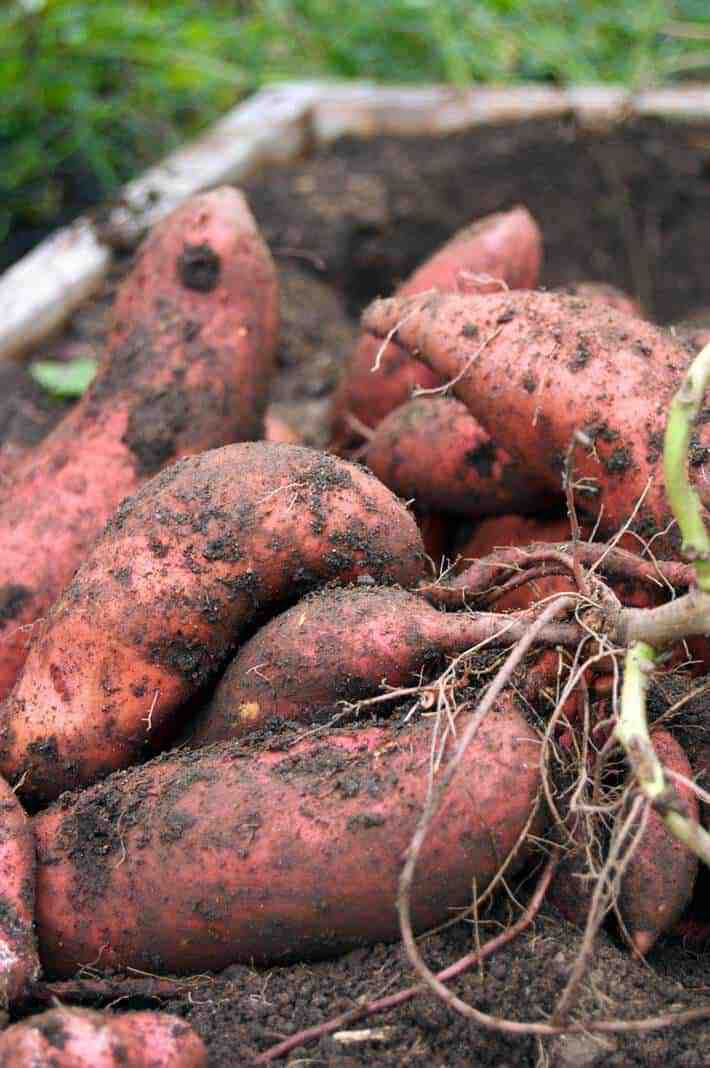
I've successfully taught thousands of you how to grow luffa in a cold climate (zone 6) and sweet potatoes (known as Kūmara where it's hugely popular in New Zealand) are no different.
It can be done and you can get a HUGE harvest even in a short season - you just need to follow the steps.
In 2010, when I first started growing sweet potatoes (Ipomoea batatas), there was almost no information on the Internet about it. At that time, growing sweet potato slips was a closely guarded secret in the farming community.
Not anymore.
Table of Contents
Two ways to grow sweet potato plants
🌱 It starts with growing the slips. 🌱
In order to grow sweet potatoes, you have to first grow sweet potato slips. These are the sprouts that come off of the sweet potato.
Every slip will grow into a sweet potato plant that will produce around 2 pounds of sweet potatoes
1. IN WATER
2. IN SOIL
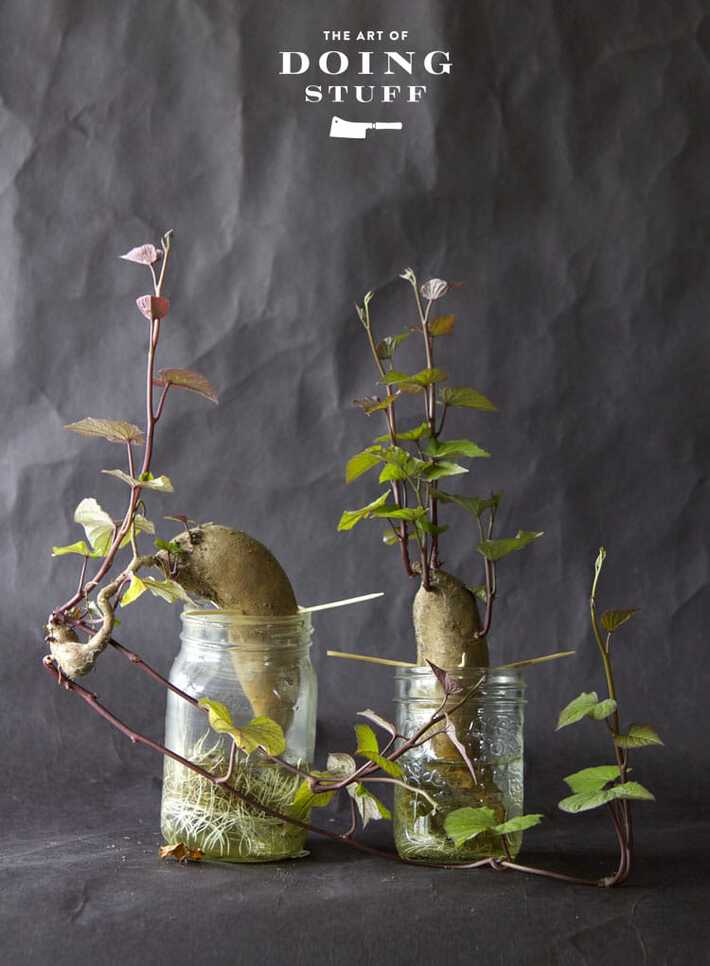
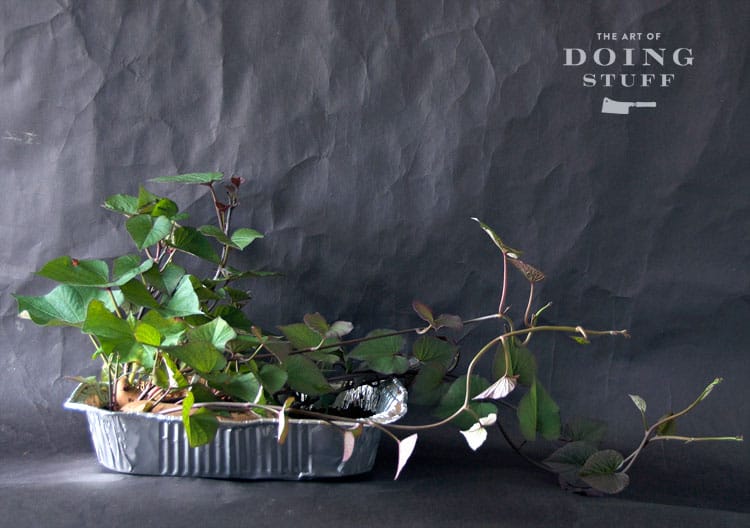
Sweet potatoes sprout after they break dormancy just like the perennial plants in your garden do. These sprouts are called slips and they're what you use to grow sweet potato plants.
You can encourage your sweet potato to break dormancy by putting it in a warm room in either a glass of water or some soil.
Water Method
With this method you're generally safe to start your slips 6 weeks prior to when you want to plant them out.
STEP 1. Place sweet potatoes in a glass jar of water with half the sweet potato under water and the rest not. The part under water will grow roots and the part above water will grow slips.
STEP 2. Put the jar somewhere WARM - over 80℉ is ideal. Now you wait about a month for it to root and sprout.
STEP 3. Once the slips are a few inches long they can be pinched off of the sweet potato and rooted in water or planted in 4" pots.
STEP 4. Slips can be planted outside once the soil temperature is 65ºF (or 18ºC).
Soil Method
The soil method produces slips more quickly. With this method you're generally safe to start your slips 4 weeks prior to when you want to plant them out.
STEP 1. Place whole sweet potato(es) lengthwise in a pan of soil so the soil comes halfway up the side of potato.
STEP 2. Place the pan on a seedling heating mat.
STEP 3. Make sure the soil stays moist and wait for it to produce roots / slips in 2 weeks or less.
STEP 4. Once the slips are a few inches long and you can either put them in a glass of water to root, or plant them directly in soil to root. Either way is fine. Rooting in a glass jar takes up a lot less space than putting each slip in a 4" pot with soil.
STEP 5. Slips can be planted outside once the soil temperature is 65ºF (or 18ºC).
TIP! It's the warmth of the heat pad that speeds up the sprouting process.
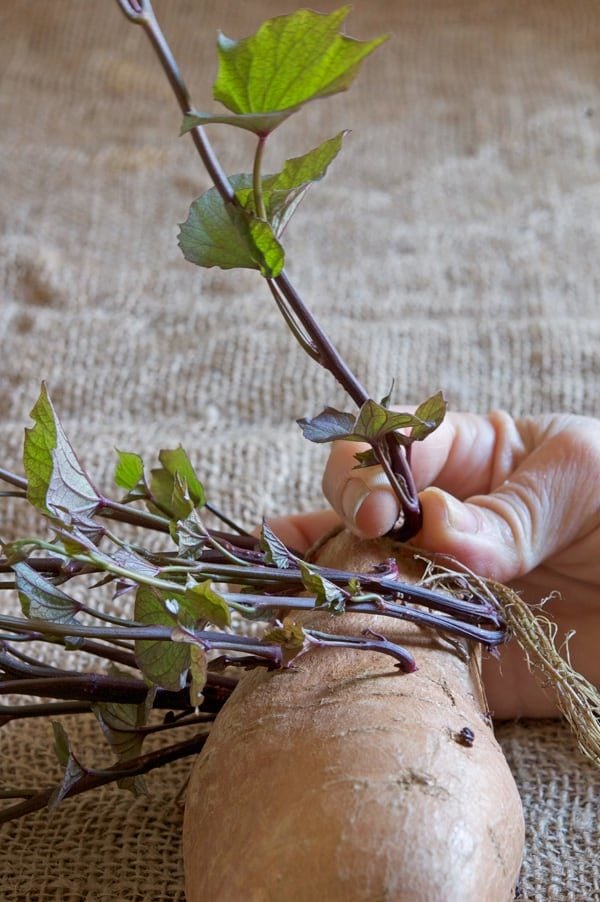
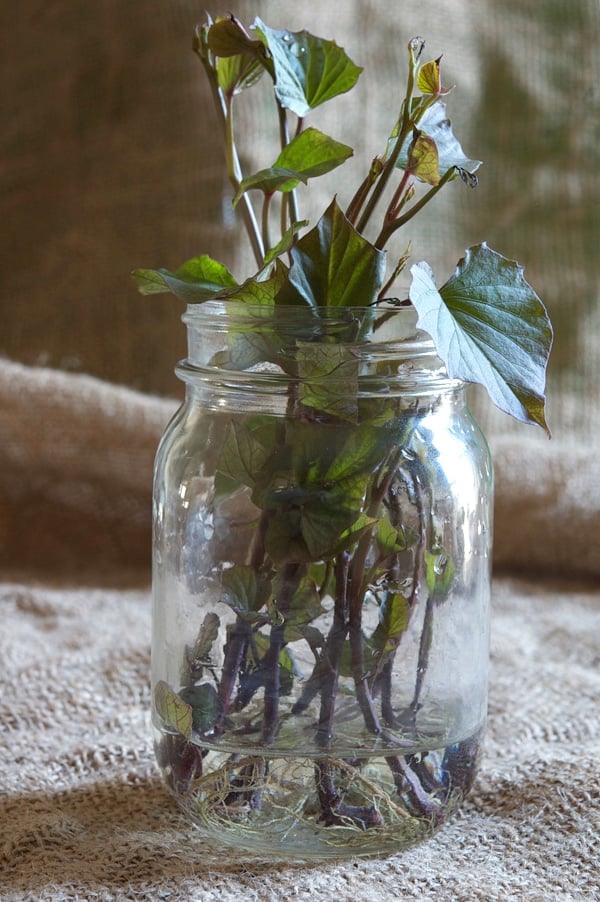
How to plant
Sweet potatoes will be one of the last things you plant in your garden. They must go in later than peppers, tomatoes and other heat loving plants because sweet potatoes need more than just warm weather. They need warm soil as well as warm air.
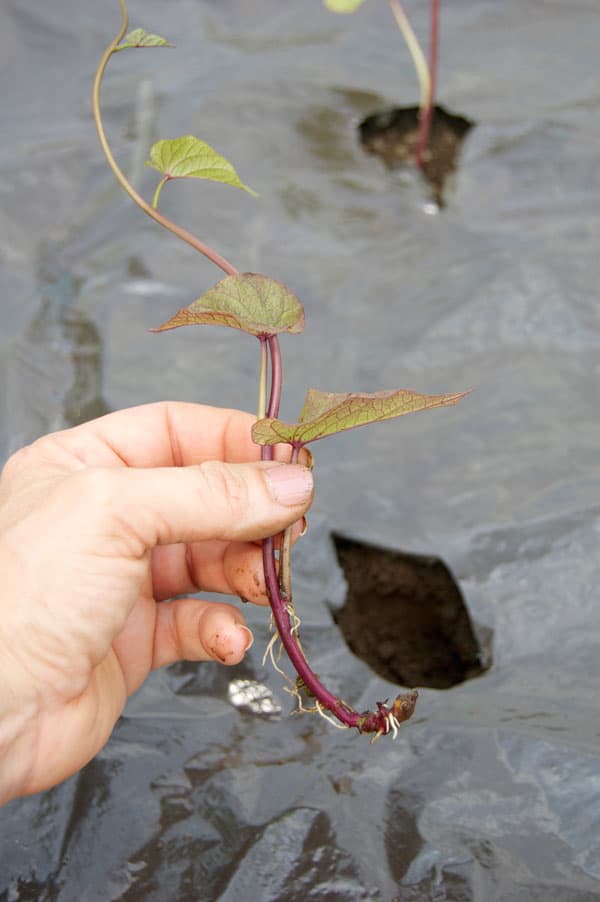
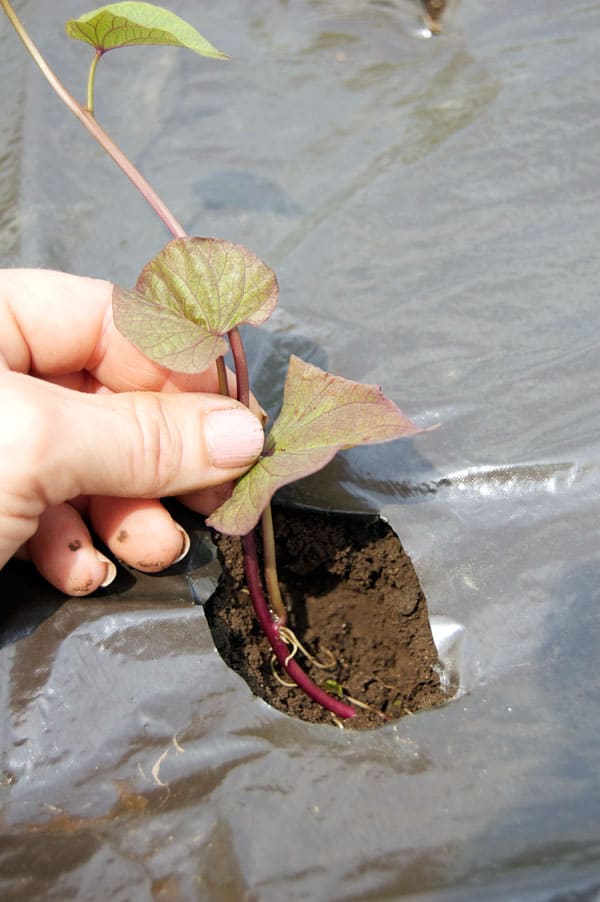
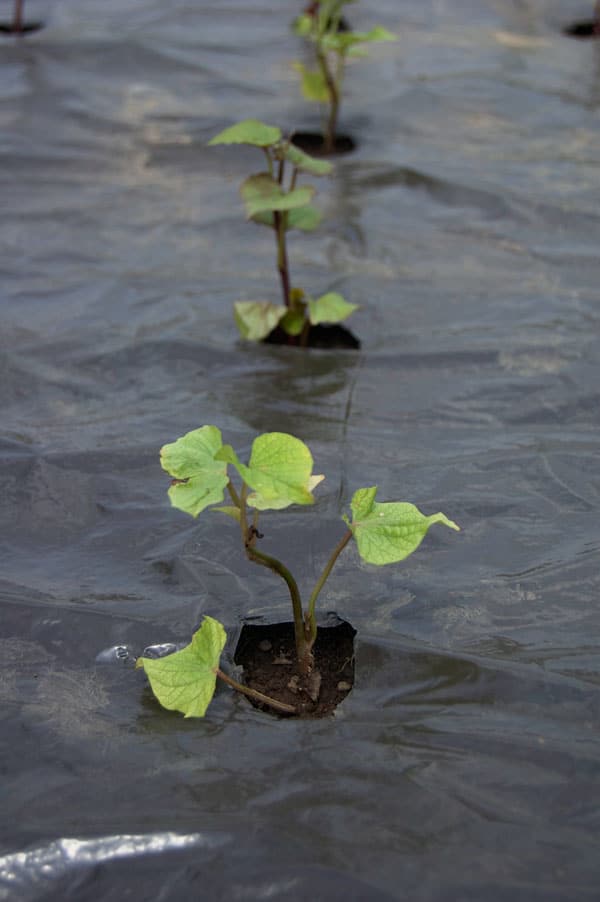
STEP 1. Apply a couple of inches of compost to the top of your soil. You can also use a slow release fertilizer; I use Gaia Green's organic 4-4-4 all purpose fertilizer in my garden.
STEP 2. Lay black thermal mulch (plastic) on the planting area 2 weeks before setting out. Sweet potatoes need full sun so make sure your area has that.
STEP 3. On planting day cut a circle in the plastic and push one slip in. Make sure the slip has contact with soil all around. Repeat for all your slips.
STEP 4. Proper spacing for planting is 1 sweet potato slip per square foot. HOWEVER, I find spacing of 16" between sweet potato plants increases your yield & the size of your sweet potatoes.
STEP 5. Keep the plants well watered throughout the summer. Using the plastic eliminates the need to weed and helps retain moisture.
STEP 6. Harvest before the first frost. Once the weather cools down they won’t grow anyway.
* Speed up your soil warming by laying a layer of black thermal plastic in your garden bed. I use biodegradable plastic made of cornstarch that just decomposes on the soil by the end of the season. It will heat the soil up by as much as 10 degrees which means you can plant the slips 1-2 weeks sooner than if you don't use thermal plastic.
.
Growing in beds
Growing in containers
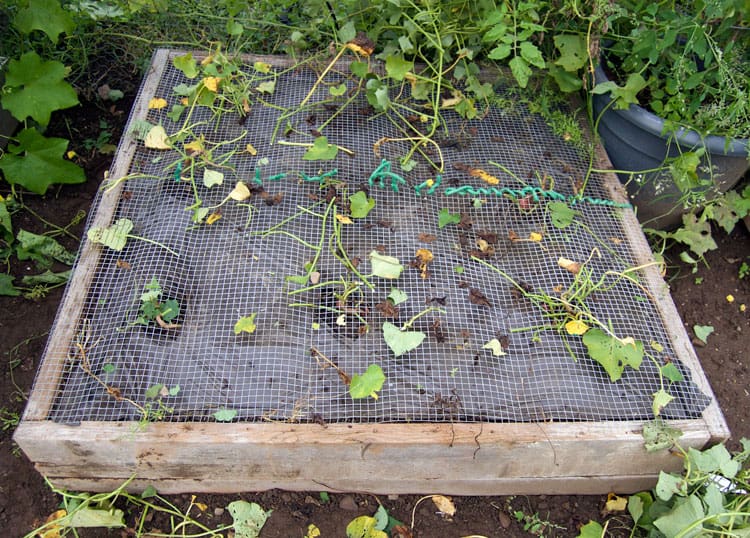
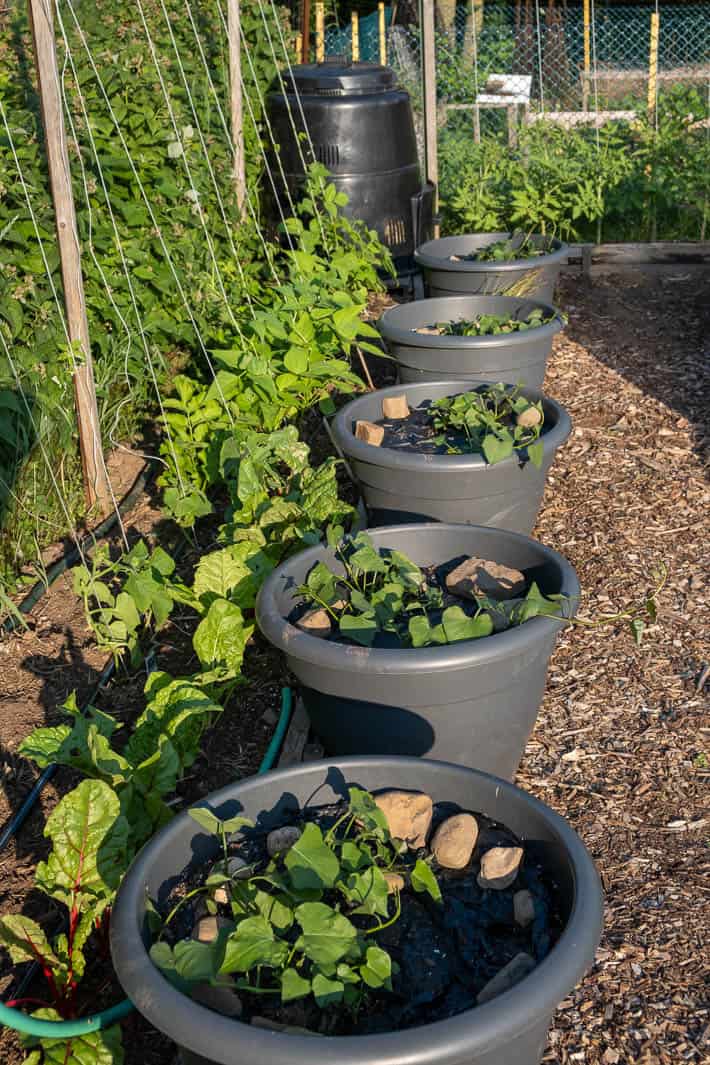
If you grow sweet potatoes in the ground you may find voles & mice get to them before you do. Hardware cloth can help with this. If you can't find it locally, Amazon carries hardware cloth.
- Cover your sweet potato bed with ¼" hardware cloth. Grow your sweet potatoes in a raised bed with wood sides. After laying your plastic down, staple hardware cloth around the edges of your bed.
- Plant the slips you have to punch a hole into the plastic with a pencil and push the slip through the hardware cloth, plastic and into the soil. THIS IS A PAIN. But it eliminates 100% of rodent damage.
I grow all of my sweet potato plants in containers.
- Plant 1-2 sweet potato slips in a 60 litre pot that measures 60 cm across.
- Remember to keep the pots watered as they'll dry out more quickly than a garden bed.
Once your plants are well established you can also harvest and eat the leaves.
Use them in: salads or cook them like you would spinach or chard.
Would you like to save this stuff?
This video shows my sweet potato harvest in 2016 after I tried using the hardware cloth the first time in a raised bed in my 40' x 40' community garden plot. In this video I'm using regular thermal plastic, not the biodegradable plastic.
How & When to Harvest
Near the end of their growing life sweet potato vines will start to yellow and croak. This is a GOOD sign! They're ready to harvest.
- Cut the tangle of vines away, leaving only a few stubs to let you know where the plants are.
- Using a shovel or digging fork, dig em up! Honestly, the most fun crops to grow are the ones that grow underground because you have NO idea what you have until the day you dig them up.
- Be careful when you're digging them and pulling them out. They bruise and break easily.
- Once they're all dug let them sit in the sun for a few hours to dry and begin the curing process.
If the vines get touched by frost and start to turn black the sweet potatoes can rot quickly so dig them up right away!
How to Cure & Store
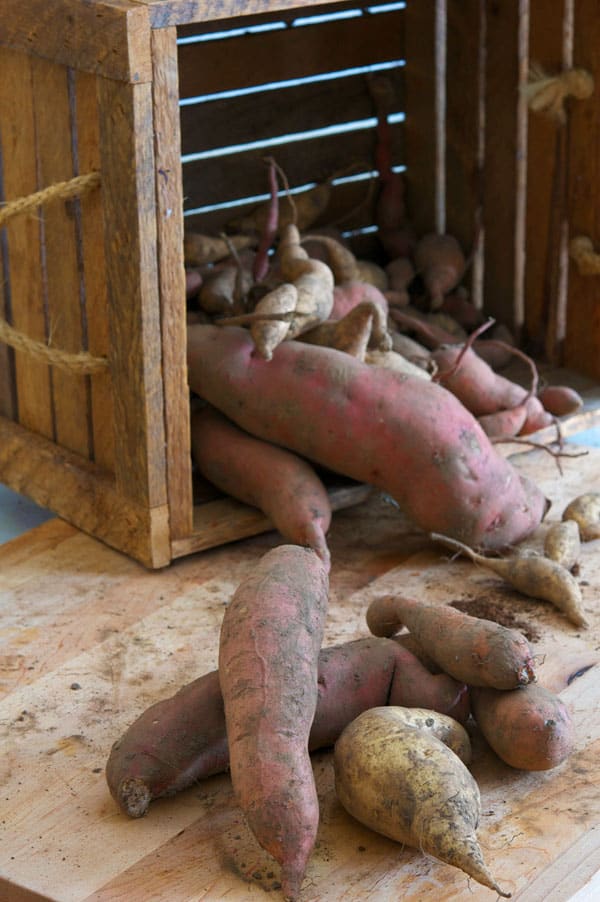
Curing
Sweet potatoes need to be cured for 10 days in an area that is 85ºF with 85% humidity. Getting those conditions at home probably seems difficult but just get as close to those ideal conditions as you can.
Why do you have to cure sweet potatoes? Curing toughens the skin so they keep longer and it develops their distinct sweet flavour. A sweet potato dug straight out of the ground won't taste sweet at all! Try it.
Here's how:
- Put your sweet potatoes in a rubber bin with the lid offset so it isn't completely sealed off. Store this near a heat register, wood stove or sunny spot. This will create conditions as close to perfect as you can get in most houses. DO THIS FOR 10 DAYS.
- After the initial 10 day curing period move your sweet potatoes to an area that is between 55-60ºF for one month. This develops their flavour. After 1 month they will have developed their sweet potato flavour which will get even stronger as time goes by.
Storing
Store sweet potatoes in an area that doesn't get below 50 degrees in a container that breathes like a slatted wood box or a burlap sack.
How many sweet potatoes do you get per plant?
2 lbs or 4 sweet potatoes per sweet potato plant.
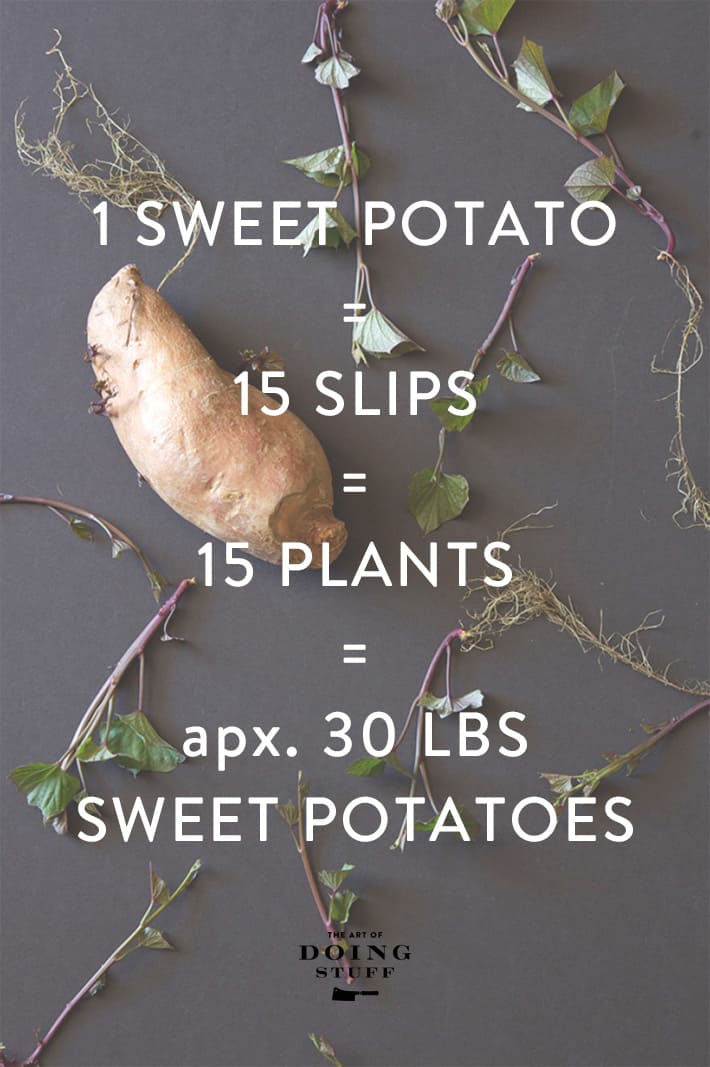
1 sweet potato plant will produce about 4 large sweet potatoes, or 2 lbs of sweet potatoes. Some varieties will produce 6 or more per plant.
The plant usually creates 1 very large sweet potato, along with a few smaller ones.
A single sprouting sweet potato can provide you with at least 15 slips (that's a low estimate). Those 15 slips will create 15 plants, which will give you around 30 lbs or 60 individual sweet potatoes.
Where to buy slips
If you don't want to grow your own you can buy potted sweet potato plants at many garden centres now and you can order live slips online.
Growing from store bought sweet potatoes
To grow your own slips all you need is a sweet potato that hasn’t been treated to stop sprouting which you can get at the grocery store.
How do you know if it’s been treated? You don’t. You go to the store, buy your sweet potato and hope for the best. Organic is your best bet for an untreated sweet potato, but both organic and "regular" store bought sweet potatoes have produced slips for me.
Tips on picking a sweet potato from the store to grow
- Check for cold damage. If the sweet potato has been exposed to below 55 degree temperatures it will probably rot rather than sprout. Cold damage presents with dark marks and lesions.
- Bigger isn't necessarily better. Small sweet potatoes, in my experience, have produced more slips than larger ones.
- Ask if they were grown locally. Locally grown means it will grow well in your region.
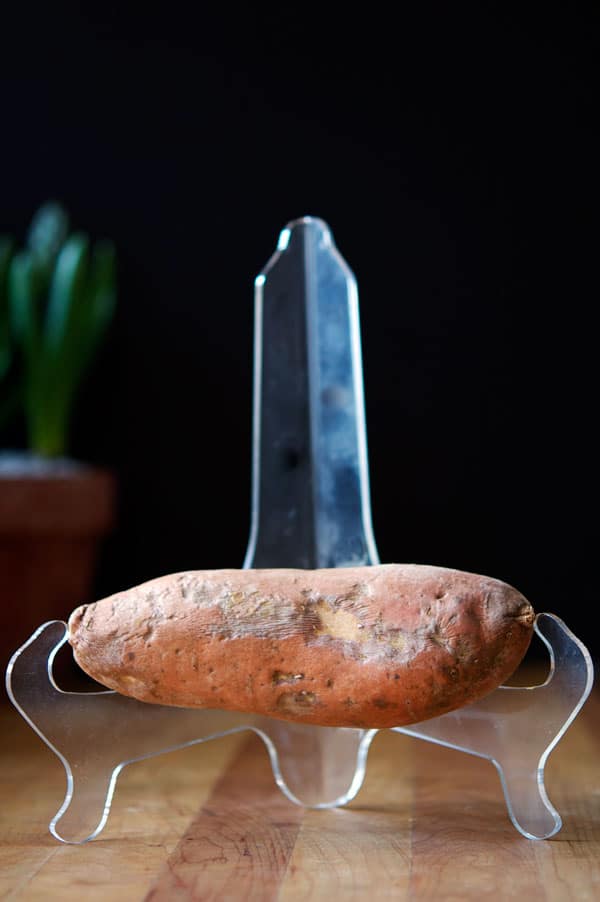
Sweet Potato with cold damage
Once you've established your very OWN crop of sweet potatoes you can use those for producing slips year after year.
Are ornamental sweet potatoes edible?
You may have noticed that your ornamental sweet potatoes also produce tubers. These tubers are edible but not delicious.
The good news is you can propagate ornamental sweet potato vine the same way as regular sweet potatoes! Just dig up the decorative sweet potato tuber in the fall, store it in a cool room, and then encourage it to grow slips in the spring. These slips can be planted directly outside or rooted and potted up for later planting.
Varieties of Sweet Potatoes
The most popular sweet potato variety by far is Beauregard and it'll be the easiest for you to find. But there are a lot more varieties than that.
- Beauregard* (best all around sweet potato variety)
- Georgia Jet (short season variety)
- Jewel (longer season but still doable in colder climates)
- Garnet (a purple variety with purple skin and flesh)
- Stokes (bright purple variety that retains its colour after cooking)
- Covington (a standard variety that grows well in cooler cliimates)
*this is the sweet potato I most often grow.
Note: I have successfully grown all of the above (with the exception of "Stokes") in my Canadian garden. I just haven't tried Stokes, but I'm sure it would be fine.
Sweet Potato VS Regular Potato
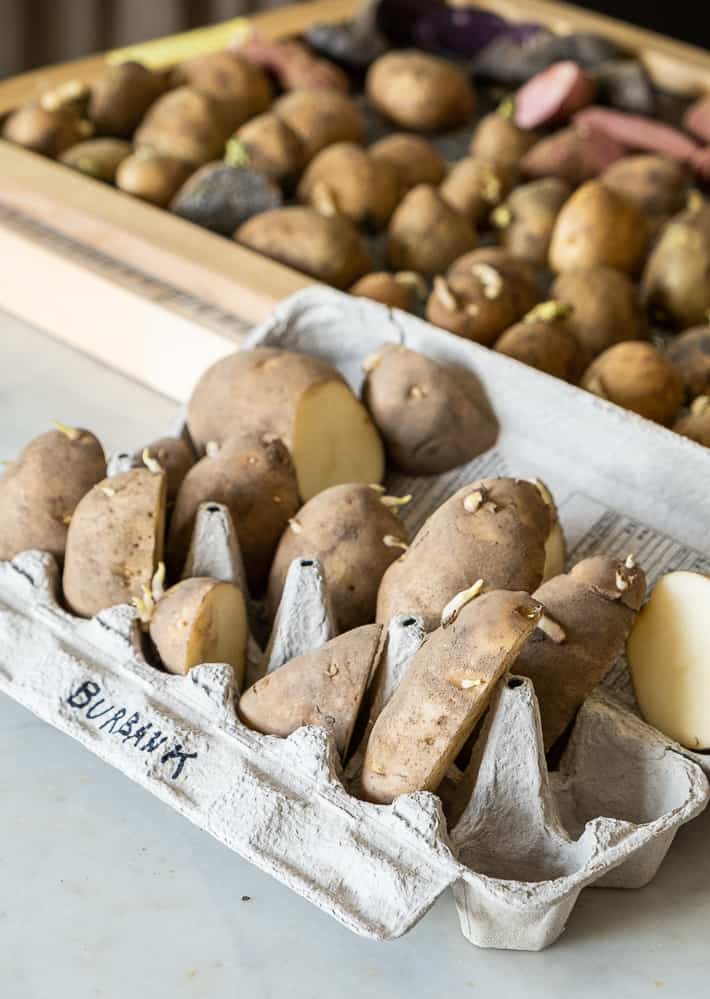
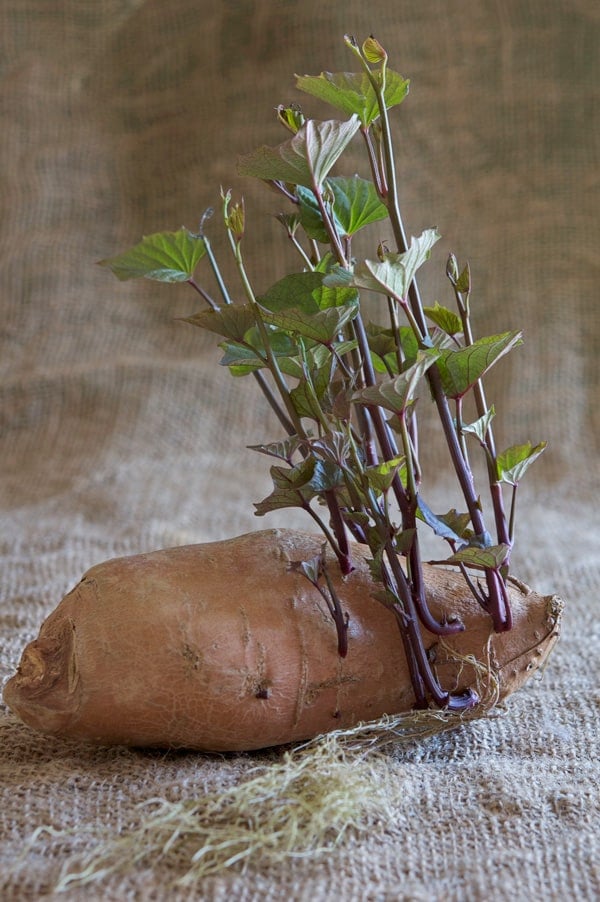
To clear up any confusion, sweet potatoes don't grow like regular potatoes. A regular potato is a tuber, a sweet potato is a root.
Regular potatoes are grown by planting whole "seed" potatoes into the ground. (here's my guide on how to grow regular potatoes)
Sweet potatoes are grown by planting only the sprouts aka slips that grow from the sweet potato.

The Start to Finish Guide to Growing Sweet Potatoes.
How to successfully grow sweet potatoes whether your garden is big or small.
Materials
- Glass of water
- Foil pan with soil
- A sweet potato
Tools
- Heat mat
Instructions
- Start sweet potato slips 6 weeks prior to planting out.
- Rest a whole, undamaged sweet potato in soil and set on a heating mat. Slips will start to grow in around 2 weeks. When around 5", break slips off of sweet potato and plant out or root in water.
- Rooted AND unrooted slips can be planted directly in the soil.
- Speed up how quickly you can plant your slips outside by laying down thermal plastic
- To prevent vole/mole/mouse damage either grow sweet potatoes in very large pots or grow in a raised bed with wood sides and ¼" hardware cloth across the top.
- Dig up sweet potatoes when the weather cools in fall.
- Cure sweet potatoes at 85F and 85% humidity for 10 days.
- Cure another month at 55-60F allowing potatoes to develop sugars.
- Store long term in vented crates or burlap bags at no colder than 50F
Sweet potatoes can be harvested 4 to 5 months after planting.
You get around 4 sweet potatoes per plant. Usually one very large one and a few smaller but still substantial ones. Some varieties under the best conditions will produce even more.
Any potting soil will work well. It has the nutrients you need. If you are reusing potting soil you'll need to amend by adding fertilizer. Adding a 4-4-4 fertilizer or a few inches of compost to the top of the depleted potting soil will revive the soil. I also use native garden soil in my sweet potato containers.
Yes, that's exactly how you grow them but you don't plant the entire sweet potato. You let the sweet potato sprout in a warm place, pull the sprouts off when they're a few inches long and then root or plant those in soil.
May or June are the best months to plant sweet potatoes outside when the soil at planting depth has warmed up to 65ºF (or 18ºC).
Yes! Sweet potatoes do really well in beds, buckets or pots. Buckets and pots are especially good for growing sweet potatoes because they keep the soil warm and prevent moles and mice from eating the growing tubers.
Once you have a whack of sweet potatoes that you've grown yourself, if stored in good conditions, they'll last you into April or even May.
You can turn them into my personal favourite guaranteed crispy Sweet Potato fries with a Sriracha/mayo dip, Sweet Potato soup or sweet potato casserole.
Now go forth and grow.
→Follow me on Instagram where I often make a fool of myself←
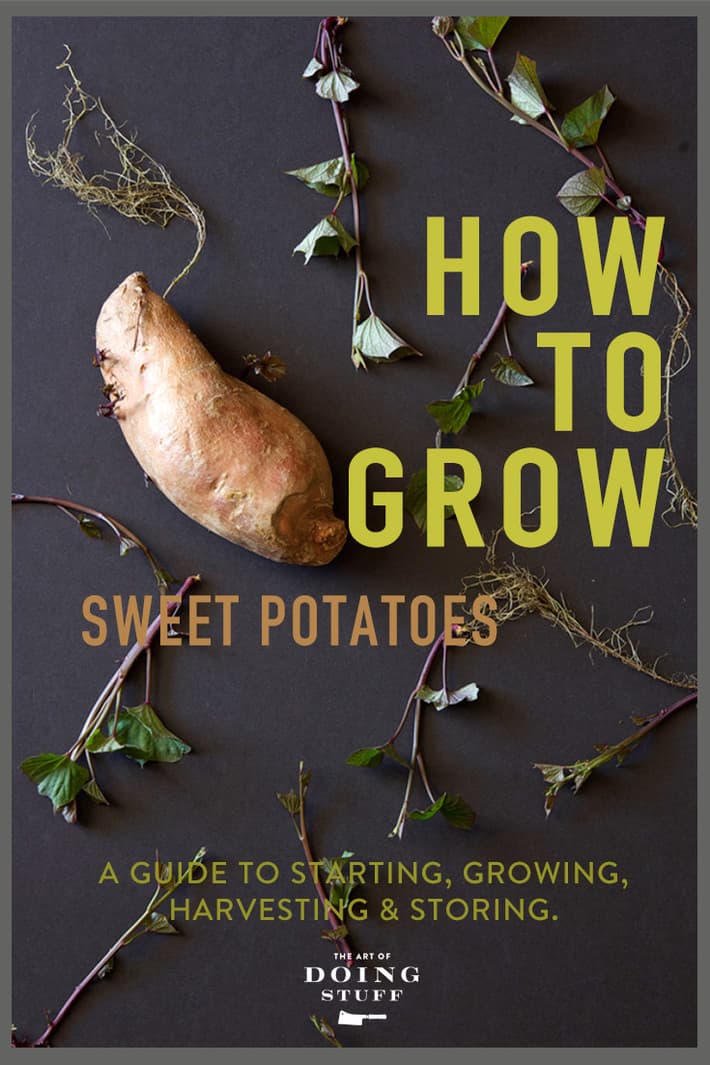

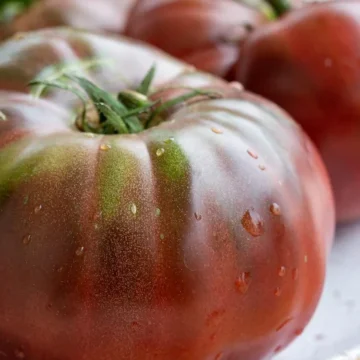
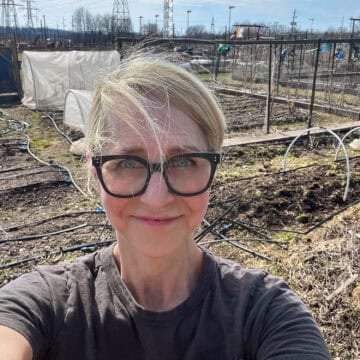
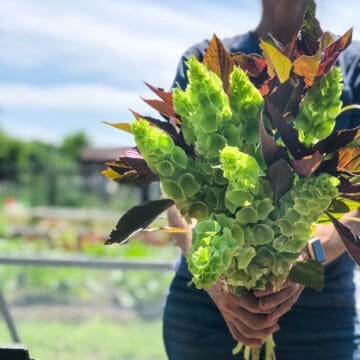

Laurie Alexander
Hi! After finding your how-to for sweet potatoes, I tried my hand at growing them. I had success growing the slips. Taking your advice about preventing mole damage, I opted for a barrel planter. The vine grew beautifully. Just today, I harvested my “crop.” Two of the potatoes are monsters! I should have entered them in the NC State Fair Agricultural Competition. Lol! The others are the average size one would expect. My main question is,... when I was pulling up the vines, I noticed a couple decent sized sweet potatoes Formed where the vine had rooted in the ground. Are these also edible? After the curing process, of course. What fun I had trying this for the first time. Thank you so much for your blog. Blessings, Grace and Peace to you this Thanksgiving season.
Laurie Alexander
*Vole (autocorrect got me)
Richard
Hi Karen, thank you for your instruction on sweet potato's. I used the new method and wow out of 2 potato's I got 50+ slips. I am pulling the plants tomorrow so I am excited the ground around the plant looks like a volcano erupting. This is my first year gardening it has been a cool experience, so once again thank you. I hope I have enough sun light left before the storms so they will dry properly before curing.
Karen
Good luck with the harvest Richard! ~ karen
Savannah
I just came across your page! You have really great instructions on how to do this! I just winged it and threw the entire rooted/viney sweet potato into a garden box… it’s going to get down to 39 at night this week so I’m going to dig em up! It was really an experiment so I’m excited to see what happened!
Karen
Hope the harvest goes well! ~ karen
Savannah
It went great!! I got way more than I expected. It’s like Christmas morning! I got 4 big ones and a bunch of medium-small ones. Excited to eat them in a while 😊
Robin
I’m trying to understand the art of growing sweet potatoes. It is August in Wisconsin and my slips have grown nicely. My question is, can I save the slips over the winter to plant them next summer.
Janet Whitworth
I just read your article which I enjoyed very much. Wish I had read it sooner. I planted the ends of potatoes in soil the middle of March and they did not start to sprout until the middle of May. They are still only 2 cm. tall. It is already late to plant them as I am in NS zone 5b so I don't want to take the time to root them. I was wondering if I can plant the sprouts still attached to the potatoes directly into the ground or would I be better off pinching off the sprouts and planting them even though they are so short.
Karen
Hi Janet. I'm afraid I think you're going to be too late for Nova Scotia. BUT I always, always try *just in case*. At 2 cm they're a bit tiny to pinch off and plant but I'd do that and stick them right in the soil. Make sure they don't dry out and cross your fingers! ~ karen
Colleen
It's currently late June where I am, is it too late to start slips and grow in a pot?
Claire RANNOU
Hi Karen
Thank you for this guide. This is my second attempt, last year I started too late and had limited success. This year I am following to the letter, the heat pad is making all the difference. I have 6 small shoots which will hopefully be big enough before the end of May for planting. Now to take care of the Luffas😵. Second attempt too. I've managed to germinate 2 and mothering them constantly. I plan to keep them in my greenhouse, I'm scared it's not hot enough here in Brittany, France.
Karen
Hi Claire! Luffa do love the heat but you'll increase your chances of success just by having a longer growing season as opposed to a hot one. So I think you have good shot in the greenhouse as long as all goes well. ~ karen!
Ruth Engelthaler
I’ve got my slips. I am worried to plant them because my entire harvest was ruined last year by some type of grub. All my potatoes had holes in them. What can I do to prep the soil to prevent my sweet potatoes being eaten by underground grubs?
Pam
Hi there!! I have been loving reading your post on sweet potatoes and all your "how to" information. I am signing up to receive your posts so I won't miss any. thanks so much for sharing
Ocean
Hi,
When you start using the new way, should the pan of soil be kept in sun or in dark place?
Karen
Hi there. You can keep the pan somewhere warm at first to trigger the eyes sprouting, and then put them under light. ~ karen!
Mike Schweichler
Three weeks ago I tried the "burry sweet potato halfway in soil" method to grow slips. Nothing.
I used organic sweet potatoes like the instructions called for. but I don't see any bumps of any kind. I could dig to see if I have roots.
Got any ideas?
Karen
Hi Mike, if you have heat under the potatoes everything is probably going according to plan. They can take a LONG time to decide to sprout. Other sweet potatoes may not sprout at all. That's part of the reason I recommend starting them so early. At this point all you can do is cross your fingers and wait. ~ karen!
Kathy
If you can't plant until June 1 and the soil needs to be warm, would you say not to bother trying in Zone 3?
Karen
Zone 3 might be tricky, but I'd never say not to try. You just have to make more of an effort to get your soil warmed up beforehand and protect them later in the season with a plastic hoop house. :) ~ karen!
Douglas kevis
Thanks Karen, great video, (and arse🤣)going to buy a couple sweet potatoes tomorrow and get my slips started. I’m doing asparagus this year too!!!
Mary W
Last year I discovered another strange but wonderful thing about sweet potatoes - their leaves. They are delicious, mild and FULL of nutrition! I just pick a few every couple days for my stir fry lunch or stick them in a sandwich. So good!!! Here in Florida sweet potatoes love to grow and one commercial grower said he lays all his tiny taters from the year before, in the ground next to each other in a layer. Then this 3-4' trench is covered and he got enough slips to plant over 4,000 plants! You are so right about using soil instead of just water. But due to your cooler conditions and using a heat mat - you have discovered the best way for a home gardener to grow out their slips. I'm going to try that since I'm very late this year. Saved my smalls to dry for dog treats but, sorry Rocky, I'm using them now to produce slips! Thanks Karen - great post.
Karen
Hi Mary! Yes, the leaves are edible! At my community garden, a lot of the gardeners are from Zimbabwe and they like the leaves, plus they grow squash mainly for the leaves as well. :) ~ karen!
Pam
Do you cut back your sweet potato vines as they are growing and taking over the garden? I grew sweet potatoes last year for the first time. I was fairly successful but ended up with many the size of a finger. My thought process was that if I cut back the vines periodically the energy would go back into making potatoes instead of the vines continually growing and trying to make new roots.
Karen
I wouldn't cut the vines. That's where they get all their energy for growing nice sweet potatoes. If yours were small the reason is more likely that you've planted them either too late and they didn't have time to form or you've planted them too close together. One very, VERY large pot should only have 1 slip planted in it. And in the ground, they need to be at least 12" apart, but 16" is even better. ~ karen!
Sabina
Oh. My. God. I just watched the 2016 sweet potato harvest video and laughed my ass off! Thank you! I needed that! And now I will be growing sweet potatoes this year!
Karen
They get very ... viney, lol. ~ karen!
Hidayah
Hello! :D I'm from Malaysia and it's hot everyday over here. So, I was wondering when should I harvest the sweet potatoes? Should I wait for the leaves turn yellow or wait a bit longer? I planted it last dec. Thank you so much :D
Krystal
Hello, Thanks so much for this helpful, informative post!
We let a sweet potato (that I thought was a yam, but looks like yours) sit on the counter too long and it grew beautiful slips(!), so we are excited to add it to our garden and grow some food with it. We will use a galvanized container; but I wanted to make sure we did things right and picked the rise size planter, so my question is:
Q: How deep does their soil need to be? Or how deep are your 60 litre pots, and how many sweet potatoes do you find tend to fit in one, from the 2 slips you plant in those?
Thanks so much for your time, and help. It's much appreciated!
Blessings, and Happy Tuesday : )
Osha Breez
You are quite an amazing teacher. Thank you. Extremely well done. And I pledge to ‘go forth and grow!’
Angela
Great, no nonsense tips on growing sweet potatoes. My great-great grandfather taught my dad, who taught me how to grow sweet potatoes. This year, 8 plants....160 pounds of s.potatoes. his only requirements are well and deep tilled soil, well drained soil, dont over water, and dig when dry, before the rodents get nosy, and the leaves turn. I only had a few potatoes with some nibbles. 😊 agreed digging produce is my favorite, too!